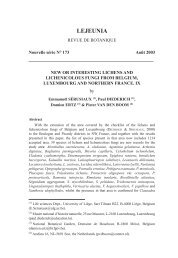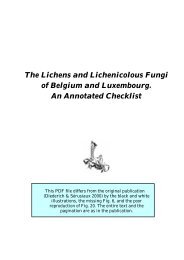A Synopsis of the Genera Skyttea, Llimoniella and - Lichens of ...
A Synopsis of the Genera Skyttea, Llimoniella and - Lichens of ...
A Synopsis of the Genera Skyttea, Llimoniella and - Lichens of ...
Create successful ePaper yourself
Turn your PDF publications into a flip-book with our unique Google optimized e-Paper software.
452 THE LICHENOLOGIST Vol. 32<br />
<strong>Llimoniella</strong>. However, a careful study <strong>of</strong> <strong>the</strong> extremely reduced holotype <strong>of</strong><br />
P. arsenii [MARSSJ, vid.] confirmed that both genera were distinct. The<br />
excipular <strong>and</strong> epihymenial pigment <strong>of</strong> P. arsenii is dark greyish to olivaceous<br />
brown, K — <strong>and</strong> N — , <strong>and</strong> none <strong>of</strong> <strong>the</strong> characteristic pigments <strong>of</strong> <strong>Llimoniella</strong><br />
have been observed. Fur<strong>the</strong>rmore, <strong>the</strong> exciple, if observed in commercial<br />
bleach (C), is very distinct, formed by loosely interwoven hyphae, similar to<br />
that <strong>of</strong> Micarea.<br />
Key to <strong>the</strong> species <strong>of</strong> <strong>Llimoniella</strong><br />
1 Ascospores ellipsoid, non-septate, 9-13 x 4-7 (im, 1-2-guttulate;<br />
K+ green pigment absent; ascomata 200-500 nm; on terricolous<br />
lichens 2<br />
Ascospores narrowly ellipsoid, elongate, fusiform or sigmoid, septate<br />
or not, 12-32 x 2-5-4 urn, multiguttulate; K+ green pigment<br />
present; on corticolous lichens 3<br />
2(1) Ascospores 9-11 x 4-5 (im; asci 65-80 x 7-10 (xm; hymenium up<br />
to 90 |jm tall; ascomatal margin scabrous; on terricolous<br />
Acarospora L. scabridula<br />
Ascospores 11-13 x 6-7 um; asci 80-90 x 8-9 |im; hymenium<br />
100-120 \iva tall; ascomatal margin ± smooth; on Placidium . . .<br />
L. adnata<br />
3(1) Ascospores non-septate, straight or curved; ascomata mainly<br />
300-500 um 4<br />
Ascospores 1-3-septate, straight, curved or sigmoid; ascomata<br />
mainly 150-350 \im 5<br />
4(3) Ascomatal margin prominent, smooth or concentrically striate, disc<br />
concave; ascospores 12-17 x 2-5-4 |xm; asci 53-61 x 7-10 um;<br />
ascomata dispersed on <strong>the</strong> thallus <strong>of</strong> Pertusaria ophthalmiza. . . .<br />
L. pertusariae<br />
Ascomatal margin less prominent, <strong>of</strong>ten not higher than <strong>the</strong> slightly<br />
concave to strongly convex disc, smooth or irregularly fissured,<br />
sometimes almost disappearing when old; ascospores 15-<br />
25 x 2-5-3-5 um; asci 40-55 x 5-7 ^m; ascomata aggregated on<br />
<strong>the</strong> thallus <strong>of</strong> Pyrenula (Fig. 8) L. pyrenulae<br />
5(3) Ascospores 1-septate, straight or slightly curved, 12-16 x 3-4 |im;<br />
asci 50-63 x 7-10 |j.m; exciple violaceous to purplish brown; on<br />
Ramalina celastri (Fig. 9) L. ramalinae<br />
Ascospores 1-3-septate, sigmoid, 15-32 x 3-4 |jm; asci 52-78 x<br />
8-11 fim; exciple wine-red; on Ochrolechia L. vinosa<br />
<strong>Llimoniella</strong> adnata Haf. & Nav.-Ros.<br />
Herzogia 9: 773 (1993); type: Spain, prov. Madrid, Gipshiigel E von Ciempozuelos, S von<br />
Madrid, auf Placidium squamulosum, ix 1980, Hafellner 8592 & Crespo (GZU, vid.).<br />
For a description <strong>and</strong> illustrations, see Hafellner & Navarro-Rosines<br />
(1993).





